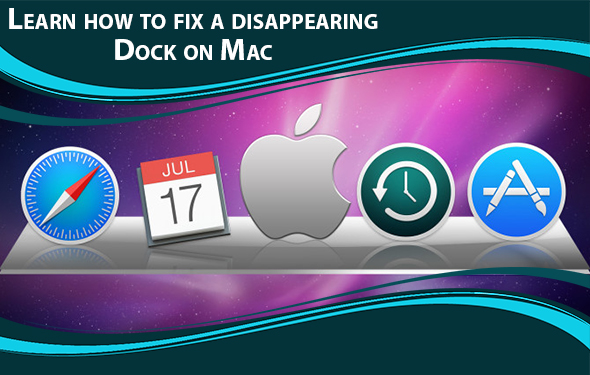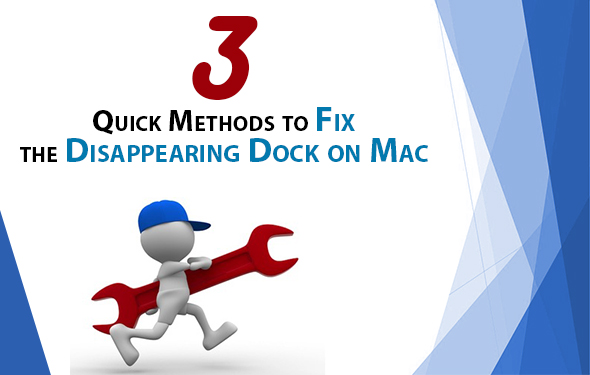 The Dock on the Mac Operating System provides you a convenient way for quick access to all the favorite applications. It enables you to launch the apps you use frequently in no-time since you don’t have to go hunting for the apps in the search bar. Therefore, it serves as a shortcut. Mac’s dock is one of the most convenient and helpful innovations of Apple. On the screen, it always sits at the bottom which neither blocks the background view nor is difficult for you to see. But, if you encounter issues with it, then a non-functioning dock often gets in the way of smooth user experience. And if a dock is constantly disappearing, it triggers more annoyance. If one of the main convenient features keep vanishing, then it creates a stir and your work slows down. To avoid this, we will discuss how to maintain the dock’s presence in your view. Follow this guide to resolve the disappearing Dock on Mac.
The Dock on the Mac Operating System provides you a convenient way for quick access to all the favorite applications. It enables you to launch the apps you use frequently in no-time since you don’t have to go hunting for the apps in the search bar. Therefore, it serves as a shortcut. Mac’s dock is one of the most convenient and helpful innovations of Apple. On the screen, it always sits at the bottom which neither blocks the background view nor is difficult for you to see. But, if you encounter issues with it, then a non-functioning dock often gets in the way of smooth user experience. And if a dock is constantly disappearing, it triggers more annoyance. If one of the main convenient features keep vanishing, then it creates a stir and your work slows down. To avoid this, we will discuss how to maintain the dock’s presence in your view. Follow this guide to resolve the disappearing Dock on Mac.
3 Quick Methods to Fix the Disappearing Dock on Mac

You can repair the constant annoying disappearance of the Mac Operating System’s dock in three convenient methods. All of the methods are effective in fixing the issue quickly. However, we suggest you begin with the first process and if that fails you, proceed to the successive alternatives. Study the methods below and act accordingly.
-
Employ the System Preferences to Set up the Dock
We recommend this method to be your initial choice since it is the simplest alternative. Select the Apple icon/button which exists in the extreme top-left corner on the screen. After that, click on the System Preferences among others in the drop-down box. A window appears where you must locate the Dock option. It is located between Desktop & Screen Saver and Mission Control on the top line. Launch it.
Once it opens, you will notice several Dock settings which also includes its resizing and positioning on the screen. Also, you can see multiple checkboxes at the window’s bottom. Among the tick boxes, inspect to see if the box saying ‘Automatically hide and show the Dock’ is unchecked. Now, this must fix the problem and maintain the Dock’s visibility.
-
Right-Click on the Dock
There is another alternative to access the Dock hide settings and that is by right-clicking on the dock itself. Since there are icons for several applications already in location, you require to search the vertical line that exists on the right side which isolates the applications from the Downloads and Trash segment. When you hover or hang the cursor on this, it alters this into a double-ended arrow. And the moment you see it, right-click to launch the quick settings menu. There, you will notice an option indicating to Turn Hiding Off. Then, select the option and your Mac’s Dock stays on screen.
-
Reset the Preference List
Now, if you still get problems with the dock disappearing time and again, you must attempt another try, this time by resetting the preference list. However, if the above alternatives don’t bring up results, this signifies that there exist some problems with a file that has probably turned corrupt.
For this, the initial thing, to begin with, is to analyze if the software requires an update. You can check it quite easily by clicking the Apple icon which is at the extreme top-left corner. Then, tap on the App Store. After it launches, click on the tab that says Updates. If you find this blank and empty, then erasing the preferences file permanently would be a strong recommendation. Doing this resets the dock to the default position and stays visible. And since it reverts back to its default settings, you require to set the shortcuts that you made earlier. That is because it deletes the record of your shortcut apps as well.
Launch the Finder and then press and hold the Options button and simultaneously click on the Go option that is in the Menu Bar. This presents the options which usually stay hidden. And the Library is one of the hidden ones. Click this after which you must choose the Preferences folder. Then, scroll down to locate the com.apple.dock.plist file. And once you locate it, delete it by dragging the file to the Trash or by selecting it and pressing the Backspace. And finally, reboot your system which enables the Mac OS to generate a new default preferences list which must resolve the issue.
Thus, you can fix it all by yourself if you follow all the mentioned methods carefully. We hope this article attended to your doubts at once. However, in case the Dock on Mac keeps disappearing, or if any problem for that matter arises, contact the experts immediately to fix them.
Frequently Asked Questions
- How do I keep the Dock on a Mac visible?
You can simply click and select the Apple key and then select the Dock from the option. After that, position it either on the right or left, according to your personal preference.
- Why does the Dock on the Mac disappear?
The cause for a disappearing Dock is probably due to the presence of a corrupt file. For this, you have to run an inspection to check if the software is up-to-date. After you finish with the updating process, launch the Finder and long-press the Options button and simultaneously click the Go option that is present in the Menu bar. This presents the options which generally stays hidden. And the library is one of the hidden ones. Select it and then choose the Preferences folder and locate the com.apple.dock.plist file. And once you locate it, proceed to delete the same.
- How do I restore or reset the Dock on my Mac?
Launch the Terminal which is present in the Utility folder. Then, type or you can copy and paste the com.apple.dock; killall Dock. After that, click Return.
- What is the Dock on the Mac Operating System?
The dock is the launching platform for desktop applications in the Mac Operating System. It is an introduction by Apple and appears for the first time on Mac OS X. The icons in this animated taskbar magnify when you hover your cursor over them. This makes it easier for you to understand what you select. Also, this is prompt in launching the applications as it creates the shortcut to frequently used apps thereby saving time. Know more about for Quick in-Detail Solutions for most Common Problems of macOS Sierra
